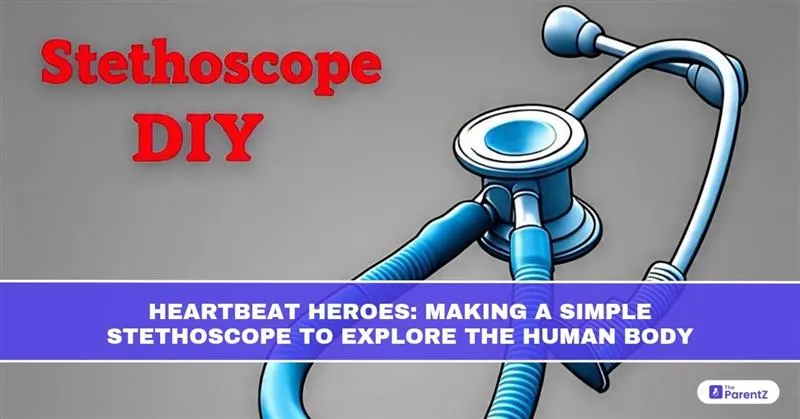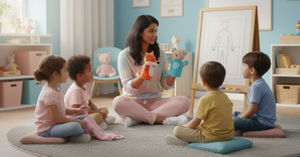“The best way to learn about the human heart is to listen—both with a stethoscope and with compassion.”
Children are fascinated by sounds—the rustle of leaves, the honk of a car, the pitter-patter of rain. But the sound that stirs the most wonder is the one they carry inside: their own heartbeat. Soft but strong, steady but alive, it’s a reminder that our body is a living, moving miracle.
What if children could hear that rhythm for themselves? What if we could give them a playful yet powerful tool to understand that this “thump-thump” isn’t just a sound—it’s life?
Welcome to Heartbeat Heroes, a simple, heartwarming DIY project that helps children build their own basic stethoscope and explore one of the body’s most important organs. It’s a blend of science, creativity, and emotion, wrapped in childlike wonder.
Why This Activity Is Special
Children often learn through touch, sound, and play. Abstract ideas—like blood circulation or cardiac function—can feel distant. But when they hear their own heart beating after a sprint across the room, everything becomes real.
They begin to ask questions like:
- “Why is it beating faster now?”
- “What does it mean if it’s slow?”
- “Is everyone’s heartbeat the same?”
This curiosity opens doors to important concepts like physical fitness, emotions, and stress, and even empathy—because when they hear a friend’s heartbeat too, they realize: we’re all alive in the same, pulsing way.
And in a world full of noise, learning to listen quietly—to one’s own body and to others—is a gentle superpower.
Building Your Simple DIY Stethoscope
You don’t need any fancy equipment to become a heartbeat explorer. Here’s what you can use from around the house:
- A clean plastic funnel (or the top of a plastic bottle)
- A length of soft rubber tubing (like aquarium air tubing)
- A small plastic cup (optional)
- Tape
To assemble:
- Fit one end of the tubing tightly into the narrow part of the funnel.
- Secure with tape if needed.
- Place the wide mouth of the funnel gently over your chest.
- Put the other end of the tubing to your ear and listen.
It won’t be as sharp as a real stethoscope, but you’ll still hear the gentle lub-dub of the heart, especially in a quiet room.
You can also experiment:
- Try listening after running in place for 30 seconds.
- Listen to different people’s heartbeats (with permission).
- Compare resting vs. active beats.
Each discovery brings more awe. “My heart is working all the time, even when I sleep!”
What Makes the Heart So Heroic?
The human heart is about the size of a child’s fist, but it’s one of the hardest-working organs in the body. Beating more than 100,000 times a day, it pumps blood rich with oxygen to every cornerbfrom tiny toes to the brain’s deepest folds.
It has four chambers and valves that open and close with each beat, creating the rhythmic sounds we hear through a stethoscope. These sounds, the lub-dub, are more than noise. They’re the sound of life in motion.
The heart also responds to emotion. It beats faster when we’re scared, excited, or happy. It slows down when we’re calm or relaxed. This makes it one of the most emotionally intelligent organs; it feels with us.
Explaining this to children helps them make connections:
“When you’re scared and your heart races, it’s not broken. It’s responding.”
“When you breathe slowly, your heart listens and slows down too.”
These are not just biology lessons—they’re lessons in self-awareness and care.
What Children Learn Through This Activity
Self-awareness
By hearing their heartbeat, children become more aware of their own bodies. It helps them notice how exercise, rest, or emotions affect their health.
Empathy
Listening to someone else’s heartbeat builds understanding. It shows that we all share a common rhythm of life. It’s a gentle reminder: we are connected.
Scientific Thinking
Kids begin to ask “how” and “why.” They learn about circulation, oxygen, pulse, and more—without needing a textbook.
Confidence in Health
Understanding the body helps children feel less afraid of hospitals or doctors. They know how things work, even a little, and that makes them braver.
Making the Learning Last
You can extend this activity in beautiful ways:
- Create a Heartbeat Journal: Draw what your heartbeat “looks” like before and after running.
- Do a Heartbeat Art Project: Paint or color to the rhythm of your heartbeat.
- Talk about healthy habits: “What can we do to keep our heart strong? Sleep well, eat fruits, dance, play outside!”
Make it a day of movement and mindfulness—a day where your child celebrates the amazing engine inside them.
A Gentle Word on Emotions and the Heart
The heart isn’t just physical—it’s deeply emotional. When we say things like “my heart is happy” or “my heart is heavy,” we’re speaking to a truth that children understand instinctively.
So let this activity open space for those conversations too:
- “What makes your heart feel light?”
- “When does it beat fast with joy?”
- “What helps calm it when it’s scared?”
These are not just science lessons—they’re life lessons.
A Closing Thought
Heartbeat Heroes is more than just a DIY project. It’s a gentle invitation for your child to listen to their body, to the miracle of life, and to the people around them.
When a child builds their own stethoscope and hears that lub-dub, they don’t just learn how the heart worksthey feel its importance.
And maybe, just maybe, in the quiet space between those beats, they’ll discover a sense of calm, curiosity, and compassion that will stay with them far beyond the activity.
So go ahead, make the funnel, find the tube, and lean in close.
Because the first sound of life is not a word.
It’s a heartbeat.
And it’s worth listening to.








Be the first one to comment on this story.